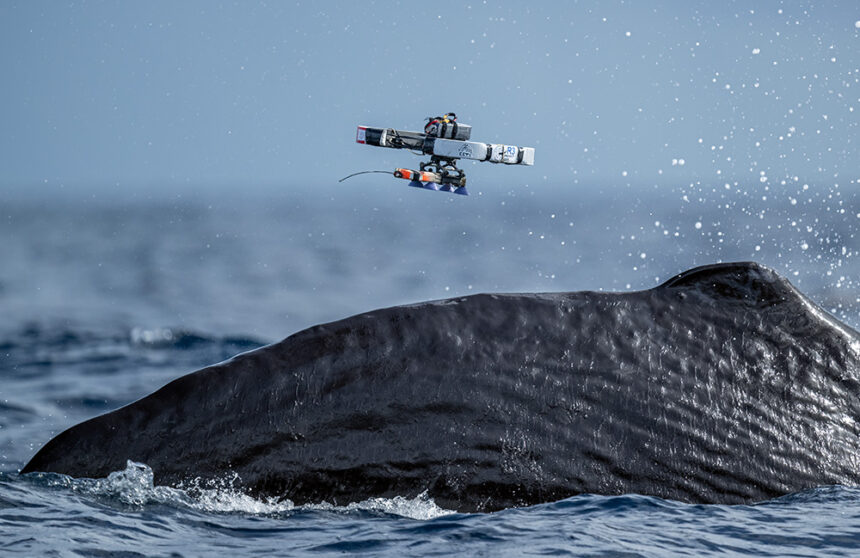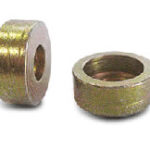A drone deploying the novel bio-inspired Project CETI tag. | Photo by ©Jaime Rojo
Researchers at the Cetacean Translation Initiative, also known as Project CETI, have worked since 2020 to use robotics and artificial intelligence to track down sperm whales and humanely collect information about them. Eventually, the organization hopes to decode the vocalizing of sperm whales.
Previously, The Robot Report has covered how Project CETI develops its biologically-inspired suction-cup tags, and how it developed special AI frameworks to determine where sperm whales will surface. Its efforts earned it a 2025 RBR50 Robotics Innovation Award. The team gave a deeper look into the drones it uses to place tags on the whales.
Once applied to a whale, Project CETI’s tags collect bioacoustics, heart rate, dive depth, and body orientation. Without robotics, researchers can apply the tags by approaching a whale from a boat and then using a long extension pole to place the tag. This is a logistically challenging and more assertive method that requires skill and precision.
Now, Project CETI uses first-person view (FPV) racing drones. The team modified them so they can withstand exposure to seawater and equips them with a custom interface, enabling them to release the tag when it is applied to the whale’s back.
“This class of drone was a natural choice since it is based on an open-source hardware/software platform,” Robert J. Wood, the Robotics Lead at Project CETI, told The Robot Report. “There is adequate power and payload to carry the tag. The platform was intended to be highly maneuverable — as opposed to more stable drones for videography, for example — and they are relatively inexpensive.”
Wood is also a professor of engineering and applied sciences at Harvard University and a National Geographic Explorer.
Whale tagging comes down to perfect timing
Sperm whales can dive deep and stay underwater for around 45 minutes, and they might be at the surface for only eight to 10 minutes. Project CETI must tag whales during this small window of time. The team decided to use aerial drones because of their speed.
“The time that the whales are on the surface is a very short window, and since aquatic drones would be much slower than aerial drones, this would require advanced knowledge of where and when the whales will surface,” Wood said. “This prediction is an active area of research — by my CETI collaborator Stephanie Gil — so this could become a viable approach in the future.”
“Regardless, aerial drones are cheap and easy to operate, so I imagine that our current approach with aerial drones will continue for the foreseeable future,” he added. “That said, we are also interested in developing surface drones that will house hydrophone arrays to listen for surfacing whales and feed that data into prediction algorithms for where they will appear.”
Project CETI’s drones are currently remotely controlled by skilled operators. During testing, deployment time was, on average, around 1 minute and 15 seconds.
“At this point, most failures are simply mistiming,” Wood said. “It is very tricky to time the approach relative to the motion of the whale and the waves. Our pilot is excellent, but that final maneuver is definitely one of the most difficult parts.”
Project CETI upgrades drones for ocean conditions
Most off-the-shelf drones aren’t prepared to handle the difficult conditions that Project CETI faces at sea. To make the drones less susceptible to water damage, the team developed a method to protect the electronic components from splashes or complete immersion in water.
“The most important changes involved waterproofing, but without deteriorating the performance of the vehicle,” said Wood. “This is not too tricky for most static components — we have a process whereby we can use a chemical vapor disposition system to coat all electrical components hermetically with a thin plastic film. And we add floatation in case of a water landing.”
“The trickiest parts are the motors since we can’t coat those in the same way as the static components, so we have to use special grease. In-field maintenance is extremely important to maintain our fleet in running order,” he explained.
In addition to waterproofing, the team installed safety measures to ensure that the drone doesn’t hurt the whale during tagging. Project CETI installed custom 3D-printed guards around each arm extremity to protect the whale from the drone’s rotating propellers.
Project CETI also had to prepare for times when a drone might fall into the water and sink. To counteract this, the team made the drone more buoyant so it would float to the surface, making it easier to retrieve.
Lessons learned from testing and next steps for Project CETI
Since using the drones, Project CETI has seen a higher deployment success rate, over 55%. This method is also less invasive than manual ones, as it doesn’t require the team to approach the whales on a boat.
“Our biggest lessons have been twofold: First, everything is much more difficult in the field than in the lab,” Wood said. “That is probably obvious, but this is one of the more challenging field robotics applications I can imagine, so anything that can go wrong will go wrong, and so preparedness is as important as our robot and controller designs.”
“Second, these animals are unpredictable, and so any encounter with them is precious,” he continued. “We have learned to have the utmost appreciation for any chance we get to interact with them … not just jumping at a chance to study them, but doing so in a respectful and gentle manner.”
Looking forward, Wood said Project CETI is interested in completely automating the tagging process.
“[Automating the tagging process] is our current focus. Not strictly using ML [machine learning] methods since we want to be more careful, and ML-based control methods would inevitably have a lot of failures that could risk the drone or even impact the whale in a less-gentle manner,” he said.
“So we are approaching this from a more conservative, classical controls approach,” Wood noted. “This first starts with a vision system being developed by our MIT collaborators that identifies the whales, their size, orientation, etc., and creates a target for where to safely place the tag. The rest of the process involves a more typical control system that maneuvers the drone to the target location before releasing the tag.”


























